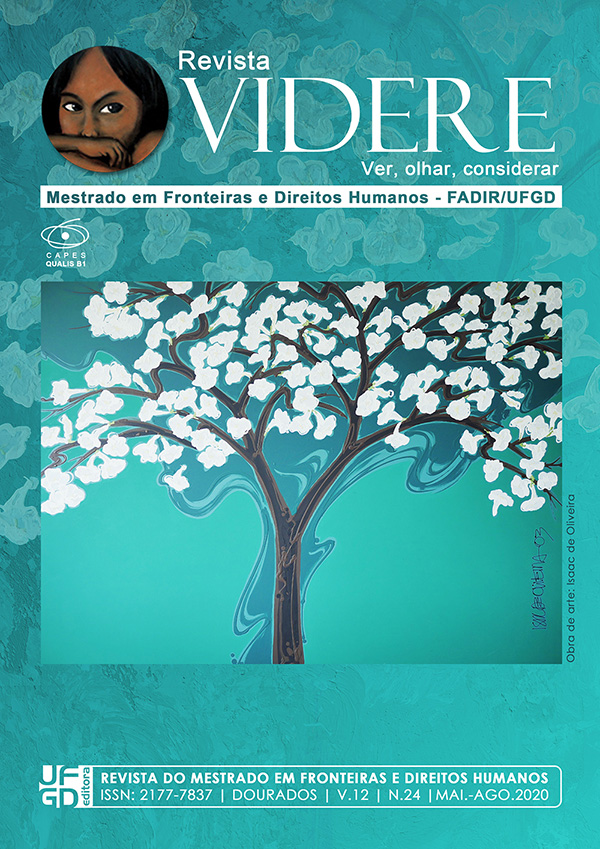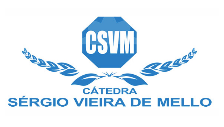Arquitetura forense e o caso Ayotzinapa: uma estética investigativa a partir das leituras de Zaffaroni e Didi-Huberman
DOI:
https://doi.org/10.30612/videre.v12i24.11506Palavras-chave:
Arquitetura forense. Ayotzinapa. Criminologia Cautelar.Resumo
Tendo como referência artística a exposição Forensic Architecture – hacia una estética investigativa realizada no Museu Universitário de Arte Contemporânea (MUAC) da Universidad Nacional Autónoma de México (UNAM) em 2017, o presente artigo problematiza as implicações destes estudos imagéticos e investigativos para o campo da criminologia. Neste sentido, trata-se de um estudo de abordagem qualitativa, de revisão bibliográfica e de análise de conteúdo e imagens, que pretende reflexionar sobre questões sociais emergentes, como a violência pública e violência estatal, lançando luzes sobre aspectos teóricos de modo transdisciplinar. A partir da necessidade de se ouvir as palavras dos mortos, conceito utilizado por Zaffaroni (2012) e a emergência dos estudos de Didi-Huberman (2004), em especial o dedicado a analisar as fotos (imagens) e as memórias do Holocausto, este estudo se debruça em pensar múltiplos caminhos e possibilidades, a fim de compreender os dias de setembro de 2014, nos quais estudantes da Escola Normal Rural de Ayotzinapa foram atacados pela polícia local em conluio com organizações criminosas, deixando como memória seis (06) pessoas mortas, quarenta (40) feridas e quarenta e três (43) estudantes desaparecidos. Desta forma, este escrito busca articular o trabalho investigativo do Forensic Architecture no interior da Criminologia Cautelar de Zaffaroni (2012), procurando oferecer elementos para reflexionar sobre as interfaces entre os campos da criminologia, da investigação criminal, das artes e dos estudos visuais.
Downloads
Referências
AGAMBEN, Giorgio. Homo sacer: o poder soberano e a vida nua. Belo Horizonte: Editora UFMG, 2002.
ALMEIDA, Manuel Antônio de. Memórias de um sargento de milícias. Brasília: Centro de Documentação Informações, Edições Câmara, 2011.
BARATTA, Alessandro. Criminologia crítica e critica do direito penal: introdução à sociologia do direito penal. Rio de Janeiro: Revan, 2002.
BOHNSACK, Ralf. A interpretação de imagens e Método Documentário. In: Sociologias, Porto Alegre, ano 9, nº 18, jun./dez. 2007, p. 286-311. Disponível em: http://www.scielo.br/pdf/soc/n18/n18a13.pdf . Acesso em: 12/03/2020.
BRANDÃO, Claudio. Curso de direito penal: parte geral. Rio de Janeiro: Forense, 2008.
DIAS, Renato Duro. Séries de animação: diálogos entre direito, arte e cultura popular. GT Direito, Arte e Literatura. Anais do XXIV Encontro Nacional do CONPEDI – UFS. Florianópolis: CONPEDI, 2015. Disponível em: http://conpedi.danilolr.info/publicacoes/c178h0tg/4d9nht62/m6Jz7T6Nrh3TVZMJ.pdf Acesso em: 12/03/2020.
DIDI-HUBERMAN, Georges. Image malgré tout. Collection Paradoxe. Paris, France; Les Édition de Minuit, 2004.
DIDI-HUBERMAN, Georges. Cascas. São Paulo: Editora 34, 2017.
DIDI-HUBERMAN, Georges. As imagens não são apenas coisas para representar. Entrevista com Georges Didi-Huberman. IHU On-line, 20/06/2017. [Entrevista cedida a] Verónica Engler, publicada por Página/12, 19/06/2017. Traduzida por André Langer. Disponível em: http://www.ihu.unisinos.br/186-noticias/noticias-2017/568830-as-imagens-nao-sao-apenas-coisas-para-representar-entrevista-com-georges-didi-huberman Acesso em: 05/03/2020.
DONNICI, Virgílio L. Polícia, guardiã da sociedade ou parceira do crime?: um estudo de criminologia. Rio de Janeiro: Forense universitária, 1990.
FORENSIC ARCHITECTURE – hacia una estética investigativa. Museu Universitário de Arte Contemporânea (MUAC), Universidad Nacional Autónoma de México (UNAM), México D.F. 2017. Editorial RM, Madrid, España, 2017.
FORENSIC ARCHITECTURE – hacia una estética investigativa. Museu Universitário de Arte Contemporânea (MUAC), Universidad Nacional Autónoma de México (UNAM), México D.F. 2017. Disponível em: https://muac.unam.mx/exposicion/forensic-architecture Acesso em: 05/03/2020.
FOUCAULT, Michel. A microfísica do poder. Rio de Janeiro: Edições Graal, 2009.
FRANCO, Marina. Un tribunal mexicano ordena investigar de nuevo el caso Ayotzinapa. New York Times, 04/06/2018. Caderno América Latina. Disponível em: https://www.nytimes.com/es/2018/06/04/ayotzinapa-comision-verdad-pgr/ . Acesso em: 05/03/2020.
Justiça mexicana afirma que os 43 estudantes de Ayotzinapa foram executados. Juízes federais descartam o delito de desaparecimento forçado durante a noite em Iguala e reforçam a teoria de homicídio.
El País, Brasil. 15/05/2016. Caderno Internacional. Disponível em:
https://brasil.elpais.com/brasil/2016/05/15/internacional/1463275908_978939.html?rel=mas. Acesso em: 12.03.2020.
Membros do Sonderkomando. Burning of Bodies. Memorial and Museum Auschwitz-Birkenau. Disponível em: http://auschwitz.org/en/gallery/historical-pictures-and-documents/extermination,11.html. Acesso em: 12/03/2020.
SANTOS, Herson Alex; DIAS, Renato Duro. Possíveis intersecções entre criminologia cultural e artes visuais. Revista de Direito, Arte e Literatura. Brasília, v. 3, n. 1, p. 39 –57, jan/jun.2017. Disponível em: https://www.indexlaw.org/index.php/revistadireitoarteliteratura/article/view/2189 . Acesso em: 05/03/2020.
SANTOS, Herson Alex. Vulnerabilidades: uma genealogia dos corpos dóceis policializados e criminalizados no contexto brasileiro. Orientador: Renato Duro Dias. 2019. Dissertação. (Mestrado em Direito e Justiça Social) - Universidade Federal do Rio Grande – FURG. Rio Grande, RS, 2019. Disponível em: https://sistemas.furg.br/sistemas/sab/arquivos/bdtd/0000012994.pdf. Acesso em: 12.03.2020.
WEIZMAN, Eyal. Forensic Architecture. Universidade de Londres, Goldsmiths – UK, 2019. Disponível em: https://forensic-architecture.org/about/agency. Acesso em: 05/03/2020.
ZAFFARONI, E. Raúl. A palavra dos mortos: conferências de criminologia cautelar. São Paulo: Saraiva, 2012.
ZAFFARONI, E. Raúl. Direito Penal Brasileiro: teoria geral do direito penal. 3ª. ed. Rio de Janeiro: Revan, 2006.
Downloads
Publicado
Como Citar
Edição
Seção
Licença
Os autores devem aceitar as normas de publicação ao submeterem a revista, bem como, concordam com os seguintes termos:
(a) O Conselho Editorial se reserva ao direito de efetuar, nos originais, alterações da Língua portuguesa para se manter o padrão culto da língua, respeitando, porém, o estilo dos autores.
(b) Autores mantém os direitos autorais e concedem à revista o direito de primeira publicação, com o trabalho simultaneamente licenciado sob a Atribuição-NãoComercial-CompartilhaIgual 3.0 Brasil (CC BY-NC-SA 3.0 BR) que permite: Compartilhar — copiar e redistribuir o material em qualquer suporte ou formato e Adaptar — remixar, transformar, e criar a partir do material. A CC BY-NC-SA 3.0 BR considera os termos seguintes:
- Atribuição — Você deve dar o crédito apropriado, prover um link para a licença e indicar se mudanças foram feitas. Você deve fazê-lo em qualquer circunstância razoável, mas de nenhuma maneira que sugira que o licenciante apoia você ou o seu uso.
- NãoComercial — Você não pode usar o material para fins comerciais.
- CompartilhaIgual — Se você remixar, transformar, ou criar a partir do material, tem de distribuir as suas contribuições sob a mesma licença que o original.
- Sem restrições adicionais — Você não pode aplicar termos jurídicos ou medidas de caráter tecnológico que restrinjam legalmente outros de fazerem algo que a licença permita.



















